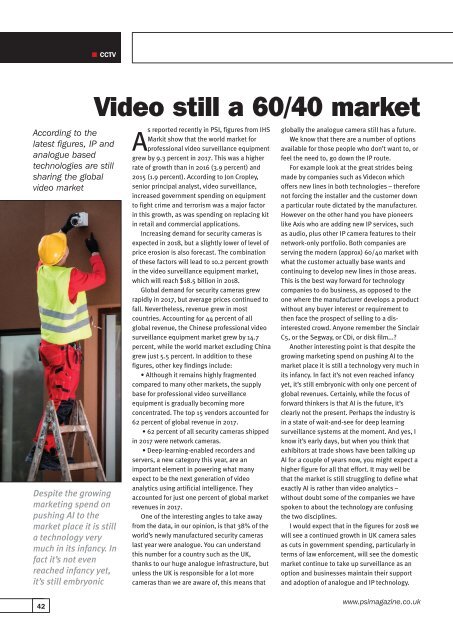PSINovember2018
You also want an ePaper? Increase the reach of your titles
YUMPU automatically turns print PDFs into web optimized ePapers that Google loves.
CCTV<br />
According to the<br />
latest figures, IP and<br />
analogue based<br />
technologies are still<br />
sharing the global<br />
video market<br />
Despite the growing<br />
marketing spend on<br />
pushing AI to the<br />
market place it is still<br />
a technology very<br />
much in its infancy. In<br />
fact it’s not even<br />
reached infancy yet,<br />
it’s still embryonic<br />
Video still a 60/40 market<br />
s reported recently in PSI, figures from IHS<br />
AMarkit show that the world market for<br />
professional video surveillance equipment<br />
grew by 9.3 percent in 2017. This was a higher<br />
rate of growth than in 2016 (3.9 percent) and<br />
2015 (1.9 percent). According to Jon Cropley,<br />
senior principal analyst, video surveillance,<br />
increased government spending on equipment<br />
to fight crime and terrorism was a major factor<br />
in this growth, as was spending on replacing kit<br />
in retail and commercial applications.<br />
Increasing demand for security cameras is<br />
expected in 2018, but a slightly lower of level of<br />
price erosion is also forecast. The combination<br />
of these factors will lead to 10.2 percent growth<br />
in the video surveillance equipment market,<br />
which will reach $18.5 billion in 2018.<br />
Global demand for security cameras grew<br />
rapidly in 2017, but average prices continued to<br />
fall. Nevertheless, revenue grew in most<br />
countries. Accounting for 44 percent of all<br />
global revenue, the Chinese professional video<br />
surveillance equipment market grew by 14.7<br />
percent, while the world market excluding China<br />
grew just 5.5 percent. In addition to these<br />
figures, other key findings include:<br />
• Although it remains highly fragmented<br />
compared to many other markets, the supply<br />
base for professional video surveillance<br />
equipment is gradually becoming more<br />
concentrated. The top 15 vendors accounted for<br />
62 percent of global revenue in 2017.<br />
• 62 percent of all security cameras shipped<br />
in 2017 were network cameras.<br />
• Deep-learning-enabled recorders and<br />
servers, a new category this year, are an<br />
important element in powering what many<br />
expect to be the next generation of video<br />
analytics using artificial intelligence. They<br />
accounted for just one percent of global market<br />
revenues in 2017.<br />
One of the interesting angles to take away<br />
from the data, in our opinion, is that 38% of the<br />
world’s newly manufactured security cameras<br />
last year were analogue. You can understand<br />
this number for a country such as the UK,<br />
thanks to our huge analogue infrastructure, but<br />
unless the UK is responsible for a lot more<br />
cameras than we are aware of, this means that<br />
globally the analogue camera still has a future.<br />
We know that there are a number of options<br />
available for those people who don’t want to, or<br />
feel the need to, go down the IP route.<br />
For example look at the great strides being<br />
made by companies such as Videcon which<br />
offers new lines in both technologies – therefore<br />
not forcing the installer and the customer down<br />
a particular route dictated by the manufacturer.<br />
However on the other hand you have pioneers<br />
like Axis who are adding new IP services, such<br />
as audio, plus other IP camera features to their<br />
network-only portfolio. Both companies are<br />
serving the modern (approx) 60/40 market with<br />
what the customer actually base wants and<br />
continuing to develop new lines in those areas.<br />
This is the best way forward for technology<br />
companies to do business, as opposed to the<br />
one where the manufacturer develops a product<br />
without any buyer interest or requirement to<br />
then face the prospect of selling to a disinterested<br />
crowd. Anyone remember the Sinclair<br />
C5, or the Segway, or CDi, or disk film...?<br />
Another interesting point is that despite the<br />
growing marketing spend on pushing AI to the<br />
market place it is still a technology very much in<br />
its infancy. In fact it’s not even reached infancy<br />
yet, it’s still embryonic with only one percent of<br />
global revenues. Certainly, while the focus of<br />
forward thinkers is that AI is the future, it’s<br />
clearly not the present. Perhaps the industry is<br />
in a state of wait-and-see for deep learning<br />
surveillance systems at the moment. And yes, I<br />
know it’s early days, but when you think that<br />
exhibitors at trade shows have been talking up<br />
AI for a couple of years now, you might expect a<br />
higher figure for all that effort. It may well be<br />
that the market is still struggling to define what<br />
exactly AI is rather than video analytics –<br />
without doubt some of the companies we have<br />
spoken to about the technology are confusing<br />
the two disciplines.<br />
I would expect that in the figures for 2018 we<br />
will see a continued growth in UK camera sales<br />
as cuts in government spending, particularly in<br />
terms of law enforcement, will see the domestic<br />
market continue to take up surveillance as an<br />
option and businesses maintain their support<br />
and adoption of analogue and IP technology.<br />
42<br />
www.psimagazine.co.uk

















